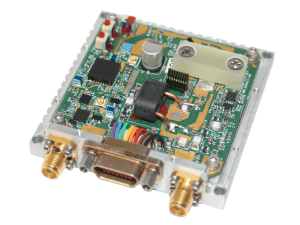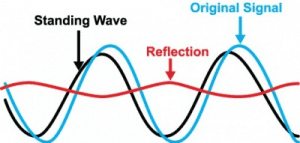One of the major decisions that a Power Amplifier (PA) Module designer must make in the development process is the choice of architecture that they will utilize in the amplification circuit. The two most widely used options are to pursue a Monolithic Microwaves Integrated Circuit (MMIC) or to design around discrete components. Each of these approaches provide the designer with certain advantages while also presenting some important challenges.

NuWaves UHF Bidirectional Power Amplifier Module that Incorporates
both MMIC and Discrete Power Amplification Circuits
MMICs
MMIC devices are commonly found components in amplifier modules, performing task such as mixing, switching, and power amplification. The trade-offs presented here will be limited to MMICs used for power amplification.
The first and most common reason for the adaptation of MMICs in microwave designs is the fact that MMIC components are small. MMICs shrink the circuity required to build complex systems to a relatively tiny package, saving the designer room and resulting in a space-saving solution for the customer. They often incorporate 10’s, 100’s or 1,000’s of “components” into a single, environmentally protected package. Many MMIC designs can also incorporate electromagnetic interference protection, as well, eliminating the need for the designer to incorporate these additional circuits in the design. Some drawbacks to their small size include lower output power capability and difficult management of thermal issues as more heat is concentrated in a small surface area.
MMIC components are also often internally matched to 50 ohms, allowing the designer greater ease in integrating them into up and downstream circuits. This comes with the disadvantage of greatly reducing the design team’s ability to fine-tune a module-level system. For the team designing a custom solution for specifications, correcting issues or improving performance is often impossible once an MMIC has been produced. If improvement or correction is required, it often means going back through the MMIC design and manufacturing process, which can often take as long as 18 months for new designs.
While the manufacturing process is lengthy, it does provide some advantages over discrete transistor networks. First, manufacturing is almost always accomplished via a machine-controlled process. This has the double effect of greatly removing human error associated with manually placed or manipulated components found in almost all discrete circuits and ensuring a higher degree of accuracy in the circuit layout. The manufacturing process also greatly reduces the production costs, at large volumes, reducing the overall cost of the product.
Discrete Circuits
Discrete devices are especially well suited for PA modules in the amplification circuit for several important reasons. While they are normally much larger in terms of physical size (and size of matching networks), discrete devices traditionally have substantially higher output power capability than MMIC devices. This means that a designer may be able to generate more power from fewer devices. In the case of high power MMICs, the designer may be forced to use a power combining approach, which negates some of the advantages of an MMICs small size as more devices are required to achieve the goals of the design.
Discrete devices also allow the designer to optimize the matching networks surrounding the devices and to choose PCB materials that maximize a circuit’s performance for a specific application. The fact that these devices are matched at the board level allows the design team to fine-tune or modify the performance of a design in an efficient and less time-consuming fashion than would be available to an MMIC design. This greatly reduces the development timeline and costs associated with the design and allows the design team some degree of freedom to make adjustments in the future as the customers’ requirements change over time.
Finally, while the initial design expense is often less relative to custom solutions when using discrete devices, the drawback is the possibility of future obsolescence issues and a higher future production cost, on average.
NuWaves RF Solutions has developed a wide variety of off-the-shelf RF amplifiers with rich features to support mission-critical CONOPS in telemetry, ISR, and tactical communication systems applications. Frequency ranges are available from UHF through C-band with output power levels ranging from 5 to 100 W.
All NuPower PAs are designed, built and tested in-house under NuWaves’ Quality Management System (QMS) certified to AS9100:2009 and ISO 9001-2008 standards, which ensures that each product arrives on-time and defect-free. Most models are in-stock. NuWaves also boasts a full suite of state-of-the-art design and simulation tools, test and measurement equipment, prototyping equipment and a full-scale production facility to provide custom solutions to your specifications. Contact NuWaves today to extend the range of your communications systems and don’t forget to check out our RF Power Amplifiers.


